The Flying Scotsman
The Flying Scotsman is a big subject that has its own chapter in "LNER Passenger Trains & Formations". Alas, there was never going to be enough room for everything so here is some extra info that adds to or enlarges on the subject, for the four phases:
- 1914-23 - 1924-37 - 1938-39 - post-WW2 and BR
New additions placed here temporarily.
A3 No 4472 Flying Scotsman near Hatfield with the Up "Flying Scotsman" in the early 1930s with the train being improved by new carriages. The formation is: (BG, TK, TK, FK, RTS....). All the carriages are on turnbuckle trussing just before steel angle trussing was introduced, on the FK.
BG - is a 1920s D.43.
TK,TK - are recently built end-vestibule designs without toplights to the windows on the corridor side to D.155 - which was introduced in 1934 and gives an approximate date for the photograph of 1934-35.
FK - is a "superfirst" to either D.139 (1930) or D.147 (1931), only two of each were built with pressure ventilation and recessed end vestibules; probably the newer diagram here which had fewer seats and was more deserving of the title "superfirst".
RTS - too far away to say any more.
The next carriage would have been the "Toilet 3rd" and though there's a hint of it, it's too blurred to confirm. Photographer unknown, author's collection.
Click on the image for an enlargement
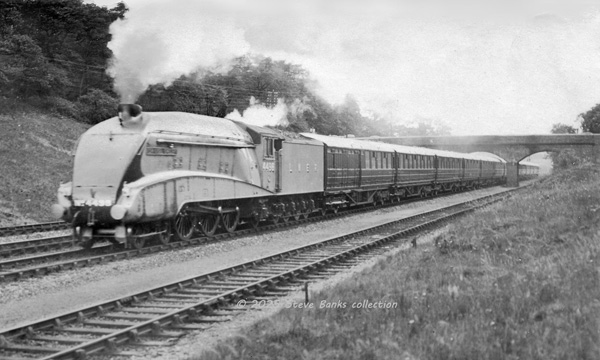
A fine view but blank on the back except for the wrong loco number! It looks like 4498 Sir Nigel Gresley approaching Greenwood on 4th July 1938 with the first public run of the "Flying Scotsman's" all-new 1938 formation. Unusually, the train headboard was not carried. Photographer unknown, author's collection.
Click on the image for an enlargement
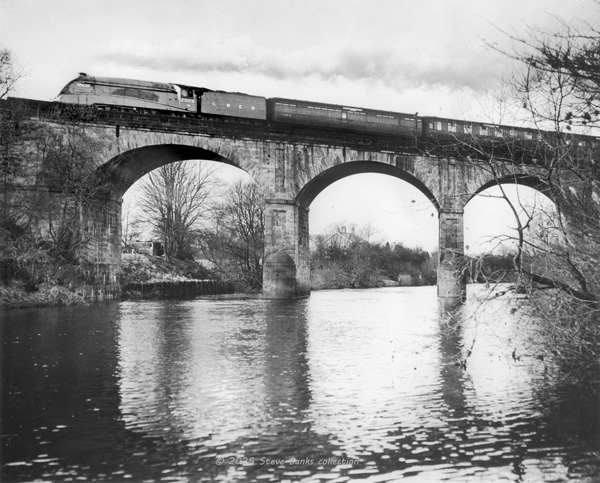 Revised caption:
Revised caption:
Frank Routledge has come forward (thank you) to identify the location of this photograph as the three-arch Tees Bridge a short distance south of Croft Spa with the train heading south. The "Flying Scotsman" is recognisable as the all-new formation of 1938 by one of the two teak-panelled BGs (Nos 1012-13 which can be read off the photograph) and FK(7) with no roof vents (=pressure ventilation). I don't have the Up formation for winter 1938 but (BG,FK…) leading is plausible.
The loco is No 2509 Silver Link in blue livery and about to ascend a short stretch of 1:391 onto the almost level 40-mile racing stretch across the North Yorkshire plain. Photographer unknown, author's collection.
Click on the image for an enlargement
Introduction
There is no known starting point for the terms "Flying Scotchman" and "Special Scotch Express" although they had existed unofficially probably as far back as the races in the 1880s/90s. The name "Flying Scotsman" for the 10am expresses between King's Cross and Edinburgh was officially started by the LNER after the Grouping and probably not fully embraced until the 1924 formation was in service.
1914-23
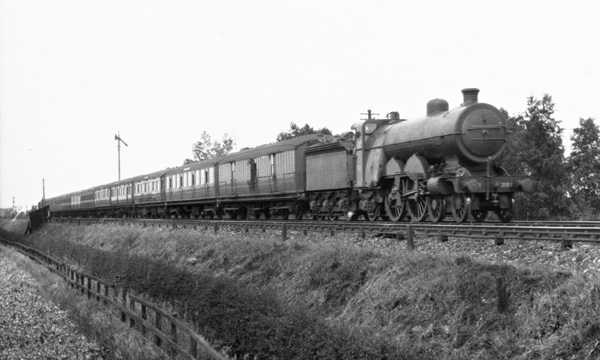
In 1914, after a British history of conflagrations after accidents involving main line expresses, the GNR designed a steel-bodied kitchen car and two were deployed in what would become the "Flying Scotsman". Designated as EC.80A they were flanked by dining cars to EC.29A and EC.75A and this picture from around 1923 shows the express at Brayton Jc hauled by C1 No 251. Fourth behind the tender is one of the Kitchen Cars surrounded by the dining cars. It's rather clean and the light gives the impression of a flush-sided carriage: you have to look closely to see the beading. Photo: LGRP.
These kitchen cars cars were replaced in 1924 by Restaurant Triplet Sets (RTS) and cascaded to lesser services on the GN- and GC-Sections, essentially in top-end Excursions. Most notable was the "Northern Belle" which was photographed many times, hence design details and that part of their history is in the "Northern Belle" topic (see link below).
Click on the image for an enlargement
Flying Scotsman 1924-37
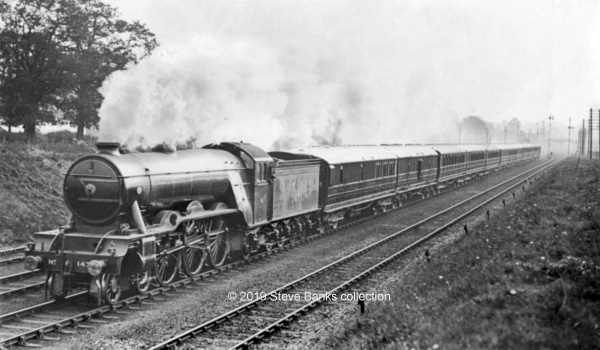
Clive and I used this picture on p.30 of LNER Trains Vol.1 while describing the early LNER formations which, in this case, was the inaugural working in 1924 of the newly equipped 12-coach formation. This is an original print from Real Photographs.
Click on the image for an enlargement

There is a b&w version of the original with a Zeppelin flying over the train(!) but this colourised one from the Locomotive Publishing Co. Ltd (LPC) is rather nice. The caption on the back reads "Flying Scotsman" at 70mph near Hatfield .... Gresley "Pacific" No 1471 "Sir Frederick Banbury" and the image is remarkably faithful to the original. The exuberance of the LNER livery shows so well, especially when the teak-panelled carriages were freshly varnished and which b&w photography concealed. Unposted postcard, Steve Banks collection.
Click on the image for an enlargement
Toilet 3rd vs 1st class saloon
"Toilet 3rd" was the internal name for a coach introduced to the Scotsman in 1928 by rebuilding a pair of 1924-built D.23 TKs by installing a ladies retiring room and a hairdressing saloon and designating it D.23A. Further improvement came in 1932 by adding a cocktail bar, which, a few years later, was turned into a buffet. The LNER promoted it as "a hotel on wheels".

This is the Diagram of the final version showing the description "cocktail bar" crossed out and "buffet" added.
Click on the image for an enlargement
When the "Northern Belle" began running with a Toilet Third in the formation, one was borrowed from the "Flying Scotsman" and replaced by an ex-GNR 1st Saloon, which can be seen in the train picture below and as far as I can tell was to GN.45D. Here is the carriage as built:

NRM, DON 30
The original running numbers were 397,807 (LNER 4397,4807) and dating from 1912, it was by far the oldest carriage in the train that was, until advent of the streamline flyers, the LNER's flagship express with regularly replaced, newly-built carriages. The Scotsman was well known for carriages unique to the train but this veteran from before the Great War - and only 52'6" long - would have stood out and quite likely surprised the 1st class clientele with its old-fashioned charm.
More details of this saloon are in topics "GNR Saloons" and "GNR 1st Saloon" (see links below)
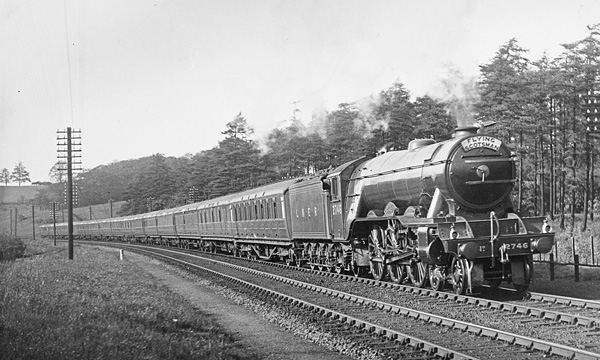
Unattributed postcard, author's collection
This picture on p.33 in the book shows the summer formation in 1934 or '35 at Ganwick with 2746 Fairway in charge of the Up train in almost its final form before complete replacement took place in 1938 (with the all-new, end-vestibule, pressure ventilated formation). Several unusual features stand out - that took place regularly but only at certain times of the year and have largely been forgotten. But first, here is the formation, as usual from behind the tender:
TK, CG / BG, FK, FSal, RTS, TK, TK, TK, TK / CK, BTK
In the middle of the train is the catering, a restaurant triplet set (RTS) and on the rear, the three-coach portion for Aberdeen:
Strengthening:- it looks like a summer Saturday and the formation has been increased from 11 to 15 coaches. Not all that noticeable in the middle and 3rd class part of the train behind the RTS, are two extra TKs fitted with roof boards. More eye-catching is the ad-hoc addition of two more coaches behind the tender, without roof boards: a 3rd and a locker composite (CG).

In this enlargement, a locker composite, second in the train, is easily recognised by the double doors. Two externally identical diagrams (D.8 and D.116) were used in the winter formation for Perth and Aberdeen - and spare in summer.
The BG - normally an all-steel one, was on this occasion an older, teak-panelled one to D.43, which had narrower panels and no ducket compared with the later D.113.
1st class carriages - Note how wide the full 1st is - these were the first coaches with end vestibules and in this Diagram they were recessed to ensure that the door handles fitted inside the loading gauge. Behind it is the 1st Class saloon which has been put on the other side of the catering, in the 1st class part of the train, between the RTS and FK. Passengers wandering through the saloon would have been a nuisance, but in this position, relatively few in number.
By way of conclusion, to underline how regularly the Scotsman was upgraded with modern stock, note how in 1934/35 (a tighter date than before thanks to John Smart using loco details), most, but not yet all of the TKs in the formation were the recently built end-vestibuled version on steel-angle trussing underframe introduced on 61'6" stock in 1934 and which, naturally, were put in the Scotsman pretty quickly.
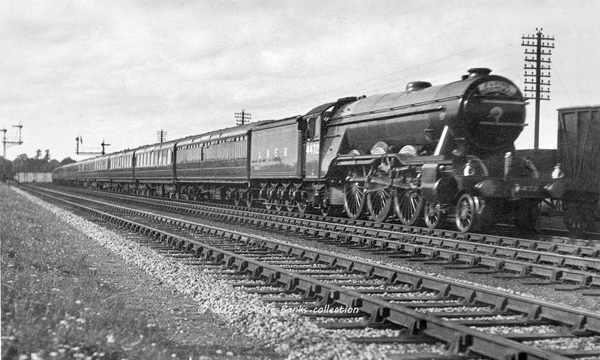
A3 No 4472 Flying Scotsman near Hatfield with the Up "Flying Scotsman" in the early 1930s with the formation being improved by new carriages. The formation is: (BG, TK, TK, FK, RTS....). All the carriages are on turnbuckle trussing just before steel angle trussing was introduced, on the FK.
BG - is a 1920s D.43.
TK,TK - are recently built end-vestibule designs without toplights to the windows on the corridor side to D.155 - which was introduced in 1934 and gives an approximate date for the photograph of 1934-35.
FK - is a "superfirst" to either D.139 (1930) or D.147 (1931), only two of each were built with pressure ventilation and recessed end vestibules; probably the later diagram here which had fewer seats and was more deserving of the title "superfirst".
RTS - too far away to say any more.
The next carriage would have been the Toilet 3rd" but it's blurred to confirm. Photographer unknown, author's collection.
Click on the image for an enlargement

The location was believed to be Durham but Frank Routledge (thank you) has flagged up some photographs in the NERA archive which show pretty conclusively that it was actually Northallerton. Haymarket's A3 No 2795 Call Boy is captured with the winter Up "Flying Scotsman". The date is unknown but would be from the mid-1930s and shows the formation after its annual overhaul with all the carriage roofs looking fresh, a feature that modellers like to reproduce a great deal, but was only seen in practice each spring when the elite "Flying Scotsman" was scrubbed up for the summer, non-stop service. A few other features stand out:
BG - behind the tender carried a destination board to advertise that its prime purpose was to carry passengers' luggage. Only one third of its space was for general traffic and parcels post for King's Cross. The actual vehicle is a rare EC-fleet D.113 (as covered by nearly all the kits and models) - in that the EC fleet only received three with turnbuckle trussing, Nos 149,117,118.
Photographer unknown, author's collection.
Click on the image for an enlargement

Maurice Earley took some of the finest steam-era pictures and this is among his best, showing A4 No 4492 Dominion of New Zealand with the Up "Flying Scotsman" in 1937 near Potters Bar. I thought at first that this is the 1938 formation because nearly all the identifiable carriages are on steel angle trussing, including a strengthening 3rd behind the tender. But it's not a 1938 end-vestibule design and the 1st further back behind the BG isn't a 1938 design either. The train shows modernisation as was regularly the case with this express, a year before the all-new train was introduced. Photo: Maurice Earley, Ian Allan postcard.
Click on the image for an enlargement

A4 No 4490 Empire of India has the "Flying Scotsman" on an unknown date and an unknown location. I would suggest that it's the Up train in 1937 with all the visible carriages at the head on steel angle trussing, but not the Diagrams introduced a year later. Photo: R.K.Blencowe Negative Archive.
Click on the image for an enlargement
The 1938 formation
We wrote this up for both the summer and winter formations and I revisit here with a twist since a photograph has come to light wrongly described by Peter Coster in one of his books as not entering service until "autumn 1938". He also miscaptioned a photograph of this train; there's quite a bit of confusion here.
The all-new, pressure ventilated train was demonstrated to the press on 30th June 1938 amid a tumult of national publicity.and entered public service four days later on 4th July 1938.
A fine view but blank on the back except for the wrong loco number! I think this is A4 No 4498 Sir Nigel Gresley approaching Greenwood on 4th July 1938 with the first public run of the "Flying Scotsman's" all-new 1938 formation. Unusually, the train headboard was not carried. Photographer unknown, author's collection.
Click on the image for an enlargement
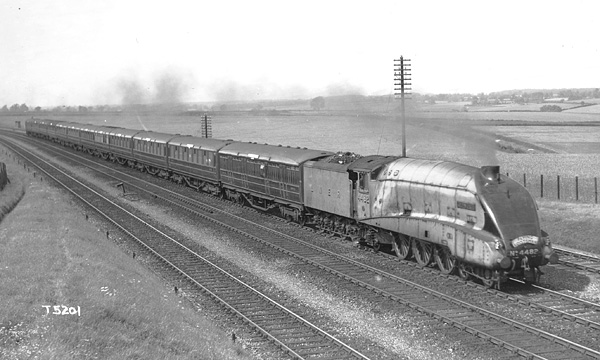
This undated picture by H Gordon Tidey (Real Photographs) was almost certainly taken a few weeks into the 1938 summer service and shows the Up train behind A4 4482 Golden eagle, which has one of the new sets led by BG No 1013.
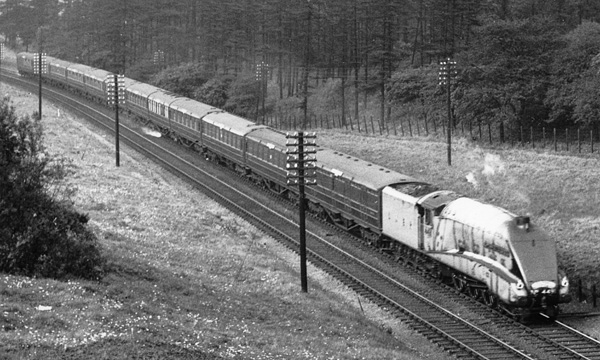
This enlargement from an ER Wethersett picture of the Up train at Ganwick behind 4491 Commonwealth of Australia was taken on 24th August 1938. The quality is a little poorer but again, the original coaches are evident, in this case the other set headed by BG No 1012. Behind the bogie van, however, there are two substitutes for the leading TK and FK - both with conventional ventilation on the roof, and the latter on turnbuckle trussing. It's hard to tell for certain but I cannot see any more substitutes further back. Stand-ins like this were perfectly normal although they don't often show up in trains as clearly as this.

Dated 15th September 1938 during the first summer's operation of the new train near Plessey, which is between Morpeth and Newcastle, with A4 No 4493 Woodcock being piloted by D49 No 264 Stirlingshire. The 4-4-0 was a Haymarket engine and one wonders if for some reason it had been put on the train from the off at Waverley, or was added after a problem arose, at Berwick, for example? The formation is visibly the all-new one of 1938. Photo: E.E. Smith.
Click on the image for an enlargement

This undated picture would date from 1938 or '39 and shows A4 No 2512 Silver Fox with the Up "Flying Scotsman" at Hatfield with the recently introduced 1938 formation The teak-panelled BG - when normal BGs were being built with steel panelling - was a harmonious part of the new train. Photo: Colling Turner, Photomatic.
Click on the image for an enlargement
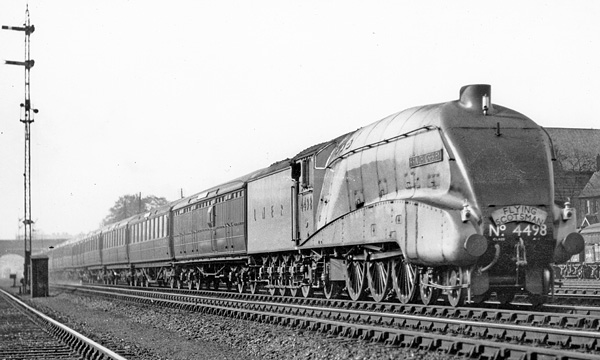
This is the picture miscaptioned by Peter Coster as "the 1928 stock [still running] in summer 1938". It's an undated GR Griggs photo (Photomatic 6196) at New Southgate with 4498 Sir Nigel Gresley in charge and as far as I can see, all the carriages bar one are very old (by ECJS standards) on turnbuckle trussing. To my eye this picture was taken in spring 1939 when the pressure-ventilated set was taken out for spring cleaning and refurbishment prior to start of the next summer timetable. Made up with spare stock, the substitute formation is remarkably vintage, especially when compared with the actual formation that by 1938 just before complete replacement had been modernised heavily with newly-built carriages with end-vestibules on steel angle trussing.
The actual choice of stock should come as no surprise for all the best carriages in the fleet were spoken for in specific trains in the normal pecking order, from the best to, shall we say, the least best. Laid aside in the carriage sidings was a selection of the principal types and qualities for substitution as required, and more or less complete spare sets that were adjusted according to need for a relief. On a busy day many trains were duplicated, occasionally even run in three "parts". And that's exactly the kind of train we're looking at here, adjusted to try and replicate the normal formation of the "Flying Scotsman". Only completely missing is the unique 1938 equivalent of the previously unique Toilet 3rd - the new Buffet Lounge. Actually, I think I can see an ex-GNR saloon in one of the pictures, but that would be stretching analysis of the negative a step too far.
In fact, there is another picture showing the same thing, taken by ER Wethersett on 8 June 1939 with an almost identical set of ancient carriages. The only visible difference was in the BG which varied between D.43 (turnbuckle) and D.260 (steel angle trussing). I don't have a print of this one and can best refer viewers to pp.40-41 of "Great Railway Photographers, ER Wethersett", Colin Garratt/NRM 1996, with the proviso that this caption wrongly describes the train as "the 1938-built set... in the summer of either 1938 or 1939". We are fortunate to have two fine pictures of this routine procedure and it's unfortunate that both have been so misrepresented.
If there's a moral in all this it's that reality bites: surviving records such as Carriage Working books that are all too often trotted out as if gospel only indicate what was planned, not what happened on a practical basis. Relatively cursory examination of the Flying Scotsman 1938 set's first year of service shows routine variations. And of course, it did enter service at the start of the summer 1938 season, running alongside the Junior Scotsman; was combined in the usual way for the winter season; and just before the next summer season started, was substituted temporarily for spring-cleaning. And so the cycle began again.

Rank Routledge has come forward (thank you) to identify this photograph as the three-arch Tees Bridge a short distance south of Croft Spa with the train heading south. The "Flying Scotsman" is recognisable as the all-new formation of 1938 by one of the teak-panelled BG (nos 1012-13 which can be seen on the photograph) and FK(7) with no roof vents (=pressure ventilation). I don't have the Up formation for winter 1938 but (BG,FK…) leading is plausible.
The loco is No 2509 Silver Link in blue livery and about to ascend a short stretch of 1:391 and reach the almost level 40 miles racing stretch across the North Yorkshire plain. Photographer unknown, author's collection.
Click on the image for an enlargement
Sample 1938 diagrams
The following selection shows the plan and vertical views (only) as help for modellers.

Selective enlargement of TK - D.256
Click on the image for an enlargement

Selective enlargement of FK - D.257
Click on the image for an enlargement

The unique buffet lounge to D.258 with ladies retiring room at one end and full length side corridor.
Click on the image for an enlargement

Selective enlargement of FK - D.259
Click on the image for an enlargement

Selective enlargement of BTK - D.261
Click on the image for an enlargement
Post-War and BR period
Covered on pages 37-41 here are some additional views:

Peppercorn A1 No 60131 Osprey on the Ganwick Curve as it emerges from Hadley Wood Tunnel with the Down "Flying Scotsman" on Wednesday 2nd September 1953. All the leading coaches are BR Mk1s. This is the north, 3rd class end of the train headed by (BTK, TK, TK, TK...).
Curiously, the loco was already allocated to Copley Hill from where it would serve until 1962 and is surprising to see on the 10am. No shed plate is being carried. A4s from King's Cross were about to take over. Photo: BR, PR & Publicity Office.
PS: there is considerable super-elevation on this curve which the BR darkroom levelled out and I have tried to repair, perhaps not quite enough?
Click on the image for an enlargement

This picture was taken at Doncaster in the very early 1950s - possibly 1949-50 when the loco was new - and shows Peppercorn A1 No 60125 Scottish Union with the Up "Flying Scotsman" during the early BR transition when the train was still granted 3-car catering via Thompson carriages - a kitchen car flanked by 1st and 3rd class dining cars - and the livery ranged between ex-LNER "teak" and BR carmine and cream. As far as I can tell, the formation is (with BR Mk.1 coaches shown with an asterisk):
BTK*, CK*, FK*, FO(dining), RK, TO(dining) ..... [rest unclear]
Note that the dining cars were branded "Restaurant Car". There seem to be 12 on with at least three carriages still carrying the simulated teak livery. We ran a Wethersett picture on p.40 of a very similar formation in 1953 at Marshmoor behind an A4 and the whole train was in carmine and cream, except for one of the BR Mk.1s, a CK, which had been substituted by a Thompson still in simulated teak. Photographer unknown, author's collection.
Click on the image for an enlargement
Related links


